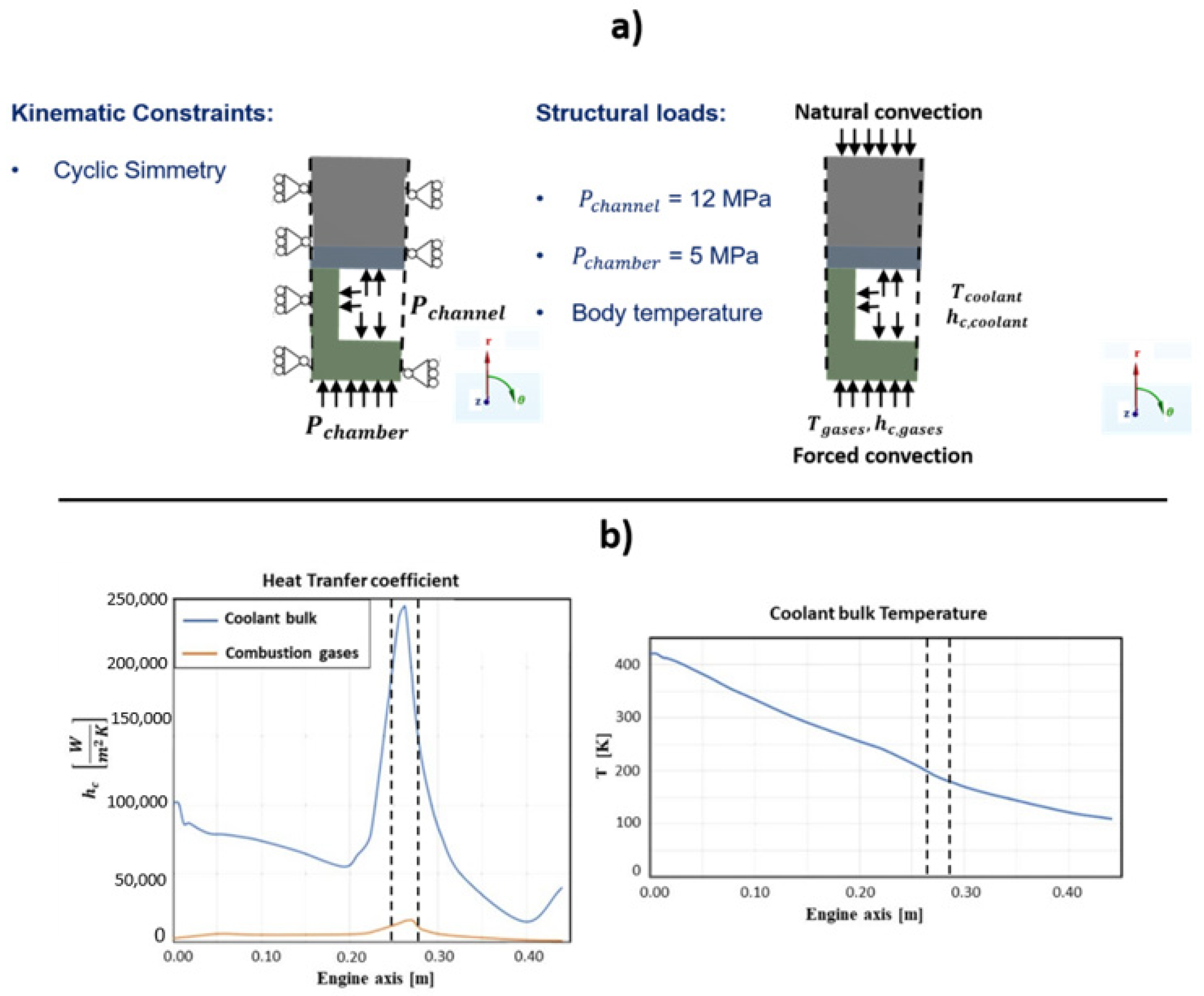Numerical Investigation on the Service Life of a Liquid Rocket Engine Thrust Chamber
Abstract
:1. Introduction
- Non-linear isotropic hardening model (VOCE) instead of the multilinear isotropic one; in such a way a saturation yield stress is considered;
- Wang–Brown fatigue criterion, using the commercial code ncode DesignLife. Fatigue results are compared with those obtained with the SWT fatigue criterion; multiaxiality non-proportional loading effects are considered.
2. Structural Model
2.1. Creep
2.2. Plasticity
- is the current yield stress,
- is the initial yield stress,
- , and are material parameters characterizing the isotropic hardening behavior of materials,
- is the equivalent plastic strain.
2.3. Low Cycle Fatigue
2.3.1. Smith Watson Topper Method
2.3.2. Wang–Brown Fatigue Method
- -
- is the maximum shear strain amplitude on critical plane;
- -
- is the normal strain excursion between two turning points of the maximum shear strain (that is the range of the normal strain experienced on the maximum shear plane over the interval from start to end of the reversal);
- -
- is the mean stress normal to the maximum shear plane;
- -
- − S is a material constant determined from a multiaxial test (default = 1);
- -
- is the effective Poisson’s ratio;
- -
- and b are parameters from Basquin law;
- -
- and c are parameters from Coffin–Manson law.
- The method adopts of a complex recursive multi-axial rainflow counting method,
- a mean stress correction method can be considered,
- the method can be adopted for proportional and non-proportional loadings,
- it may be slow for long loading histories,
- evaluates a different critical plane for each rainflow reversal.
3. Description of Numerical Model
- CuCrZr alloy, in the zone in contact with the hot gases and the coolant;
- a thin layer of electrodeposited oxygen-free high-thermal conductivity copper (OFHC Cu);
- a layer of electrodeposited nickel to afford adequate chamber stiffness.
4. Thermostructural Cycle Description
- an ignition transient phase elapsing 3 s in which the activation of the thermal combustion occurs,
- a hot phase with duration of 100 s corresponding to the combustion,
- a purging phase with duration of 3 s, during which liquid oxygen is injected inside the channels to eliminate any waste produced during the combustion process,
- a relaxation phase, lasting around 4000 s, to recover the chamber temperature back to room temperature and consisting of natural convection only.
5. Results and Discussions
6. Conclusions
Author Contributions
Funding
Data Availability Statement
Conflicts of Interest
References
- Hannum, N.P.; Kasper, H.J.; Pavli, A.J. Some effects of thermal-cycle induced deformation in rocket thrust chambers. In Proceedings of the AIAA/SAE 12th Propulsion Conference, Palo Alto, CA, USA, 26–29 July 1976; pp. 76–685. [Google Scholar]
- Quentmeyer, R.J. Experimental fatigue life investigation of cylindrical thrust chambers. In Proceedings of the AIAA/SAE 13th Propulsion Conference, Orlando, FL, USA, 11–13 July 1977; pp. 77–893. [Google Scholar]
- Gernoth, A.; Riccius, J.R.; Haidn, O.J. TMF panel tests: Close-to-reality simulation of thermo-mechanical fatigue processes in heat-loaded walls. In Proceedings of the AIAA/ASME/SAE/ASEE 44th Joint Propulsion Conference, Hartford, CT, USA, 21–23 July 2008. [Google Scholar]
- Arya, V.K.; Halford, G.R. Finite Element Analysis of Structural Engineering Problems Using a Viscoplastic Model Incorporating Two Back Stresses; TM-106046; NASA: Washington, DC, USA, 1993. [Google Scholar]
- Citarella, R.; Ferraiuolo, M.; Perrella, M.; Giannella, V. Thermostructural Numerical Analysis of the Thrust Chamber of a Liquid Propellant Rocket Engine. Materials 2022, 15, 5427. [Google Scholar] [CrossRef] [PubMed]
- Ferraiuolo, M.; Perrella, M.; Giannella, V.; Citarella, R. Thermal–Mechanical FEM Analyses of a Liquid Rocket Engines Thrust Chamber. Appl. Sci. 2022, 12, 3443. [Google Scholar] [CrossRef]
- Chaboche, J.L. A review of some plasticity and viscoplasticity constitutive theories. Int. J. Plast. 2008, 24, 1642–1693. [Google Scholar] [CrossRef]
- Asraff, A.K.; Sheela, S.; Paul, A.; Mathew, A.; Savithri, S. Cyclic stress analysis of a rocket engine thrust chamber using chaboche, voce and creep constitutive models. Trans. Indian Inst. Met. 2016, 69, 495–500. [Google Scholar] [CrossRef]
- Palma, M.D. Hardening parameters for modelling of CuCrZr and OFHC copper under cyclic loadings. In Proceedings of the 2013 IEEE 25th Symposium on Fusion Engineering (SOFE), San Francisco, CA, USA, 10–14 June 2013; pp. 1–5. [Google Scholar] [CrossRef]
- Song, J.; Sun, B. Thermal-structural analysis of regeneratively-cooled thrust chamber wall in reusable LOX/Methane rocket engines. Chin. J. Aeronaut. 2017, 30, 1043–1053. [Google Scholar] [CrossRef]
- Riccius, J.R.; Haidn, O.J.; Zametaev, E.B. Influence of time dependent effects on the estimated life time of liquid rocket combustion chamber walls. In Proceedings of the 40th AIAA/ASME/SAE/ASEE Joint Propulsion Conference and Exhibit, Fort Lauderdale, FL, USA, 11–14 July 2004. [Google Scholar]
- Thiede, R.G.; Riccius, J.R.; Reese, S. Life prediction of rocket combustion-chamber-type thermomechanical fatigue panels. J. Propuls. Power 2017, 33, 1529–1542. [Google Scholar] [CrossRef]
- Borja, R.I. Plasticity Modeling and Computation; Springer: Berlin/Heidelberg, Germany, 2013; p. 255. ISBN 9783642385476. [Google Scholar] [CrossRef]
- You, J.-H.; Miskiewicz, M. Material parameters of copper and CuCrZr alloy for cyclic plasticity at elevated temperatures. J. Nucl. Mater. 2008, 373, 269–274. [Google Scholar] [CrossRef] [Green Version]
- Broggiato, G.B.; Campana, F.; Cortese, L. The Chaboche nonlinear kinematic hardening model: Calibration methodology and validation. Meccanica 2008, 43, 115–124. [Google Scholar] [CrossRef]
- Araujo, M.C. Non-Linear Kinematic Hardening Model for Multiaxial Cyclic Plasticity. Master’s Thesis, Louisiana State University, Baton Rouge, LA, USA, 2002; p. 1650. Available online: https://digitalcommons.lsu.edu/gradschool_theses/1650 (accessed on 10 January 2023).
- Calì, C.; Cricrì, G.; Perrella, M. An advanced creep model allowing for hardening and damage effects. Strain 2010, 46, 347–357. [Google Scholar] [CrossRef]
- Golan, O.; Arbel, A.; Eliezer, D.; Moreno, D. The applicability of Norton’s creep power law and its modified version to a single-crystal superalloy type CMSX-2. Mater. Sci. Eng. A 1996, 216, 125–130. [Google Scholar] [CrossRef]
- Giannella, V.; Citarella, R.; Fellinger, J.; Esposito, R. LCF assessment on heat shield components of nuclear fusion experiment “Wendelstein 7-X” by critical plane criteria. Procedia Struct. Integr. 2018, 8, 318–331. [Google Scholar] [CrossRef]
- Li, G.; Thomas, B.J. Modeling Creep and Fatigue of Copper Alloys. Metall. Mater. Trans. A 2000, 31, 2491–2502. [Google Scholar] [CrossRef]
- Ferraiuolo, M.; Russo, V.; Vafai, K. A comparative study of refined and simplified thermo-viscoplastic modeling of a thrust chamber with regenerative cooling. Int. Commun. Heat Mass Transf. 2016, 78, 155–162. [Google Scholar] [CrossRef]
- Chen, H.; Shang, D.-G.; Tian, Y.-J.; Liu, J.-Z. Comparison of multiaxial fatigue damage models under variable amplitude loading. J. Mech. Sci. Technol. 2012, 26, 3439–3446. [Google Scholar] [CrossRef]
- Ferraiuolo, M.; Leo, M.; Citarella, R. On the Adoption of Global/Local Approaches for the Thermomechanical Analysis and Design of Liquid Rocket Engines. Appl. Sci. 2020, 10, 7664. [Google Scholar] [CrossRef]
- Esposito, J.J.; Zabora, R.F. Thrust Chamber Life Prediction. Volume 1: Mechanical and Physical Properties of High Performance Rocket Nozzle Materials; NASA-CR-134806, D180-18673-1-VOL-1; NASA: Washington, DC, USA, 1795. [Google Scholar]
- Ricci, D.; Battista, F.; Ferraiuolo, M.; Salvatore, V.; Fragiacomo, M. Methane Transcritical Behavior in the Cooling System of the HYPROB-BREAD LOX/LCH4 Demonstrator Rocket Engine. In Proceedings of the ASME 2015 International Mechanical Engineering Congress and Exposition, Houston, TX, USA, 13–19 November 2015. [Google Scholar] [CrossRef]
- Ricci, D.; Battista, F.; Fragiacomo, M. Transcritical Behavior of Methane in the Cooling Jacket of a Liquid-Oxygen/Liquid-Methane Rocket-Engine Demonstrator. Energies 2022, 15, 4190. [Google Scholar] [CrossRef]
- Masuoka, T.; Riccius, J.R. Life evaluation of a combustion chamber by thermomechanical fatigue panel tests based on a creep fatigue and ductile damage model. Int. J. Damage Mech. 2020, 29, 226–245. [Google Scholar] [CrossRef]
- Porowski, J.S.; O’Donnell, W.; Badlani, M.L.; Kasraie, B.; Kasper, H.J. Simplified design and life prediction of rocket thrust chambers. J. Spacecr. Rocket. 1985, 22, 181–187. [Google Scholar] [CrossRef]
- DesignLife Theory Guide 1, NC-DL-TH 9.00.092. Available online: www.ncode.com (accessed on 15 May 2022).
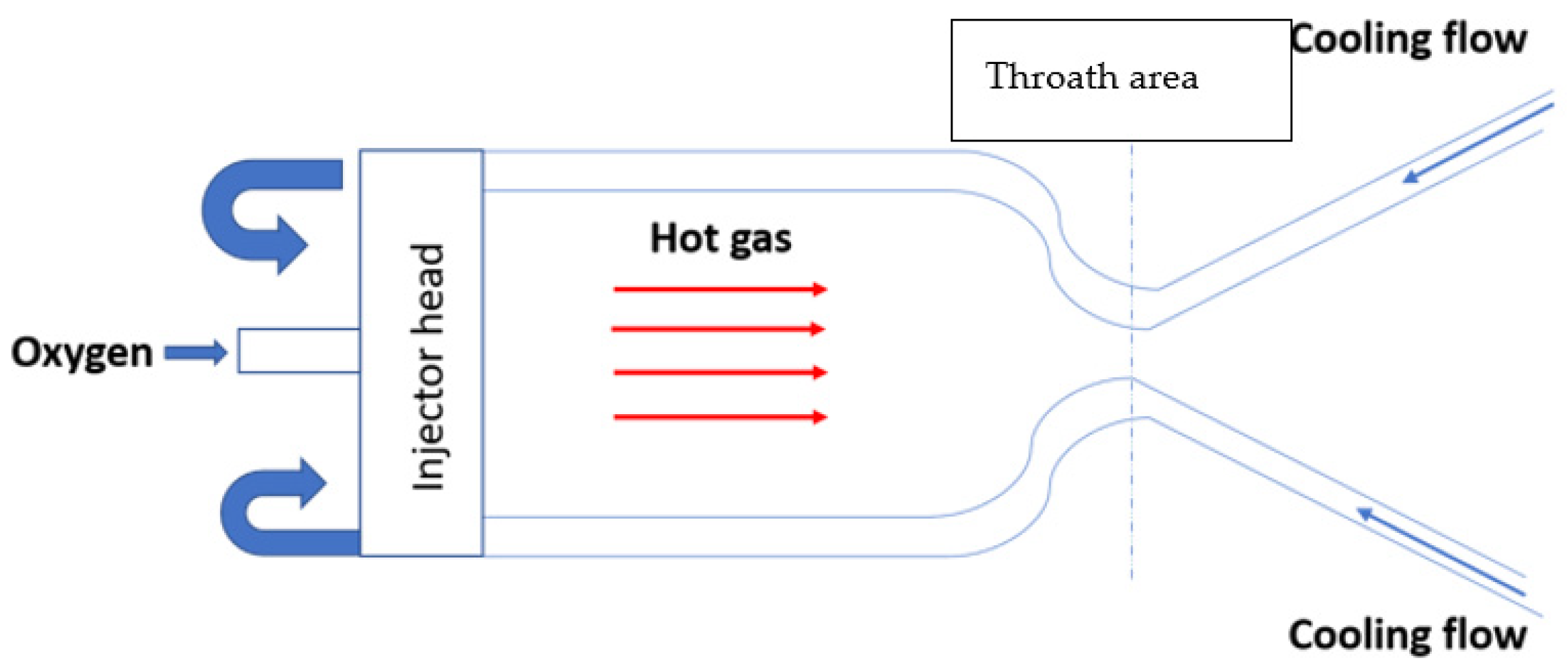



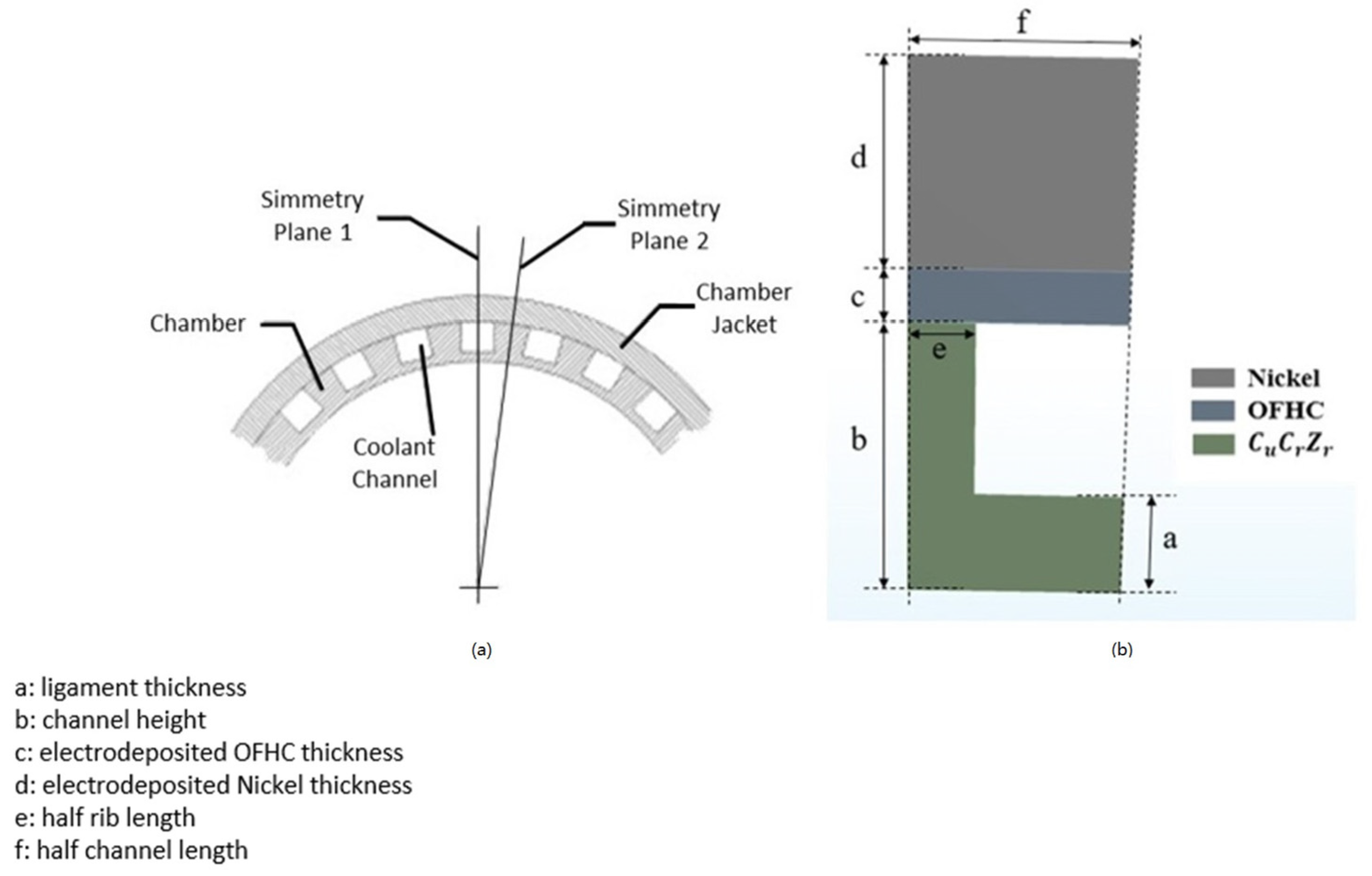


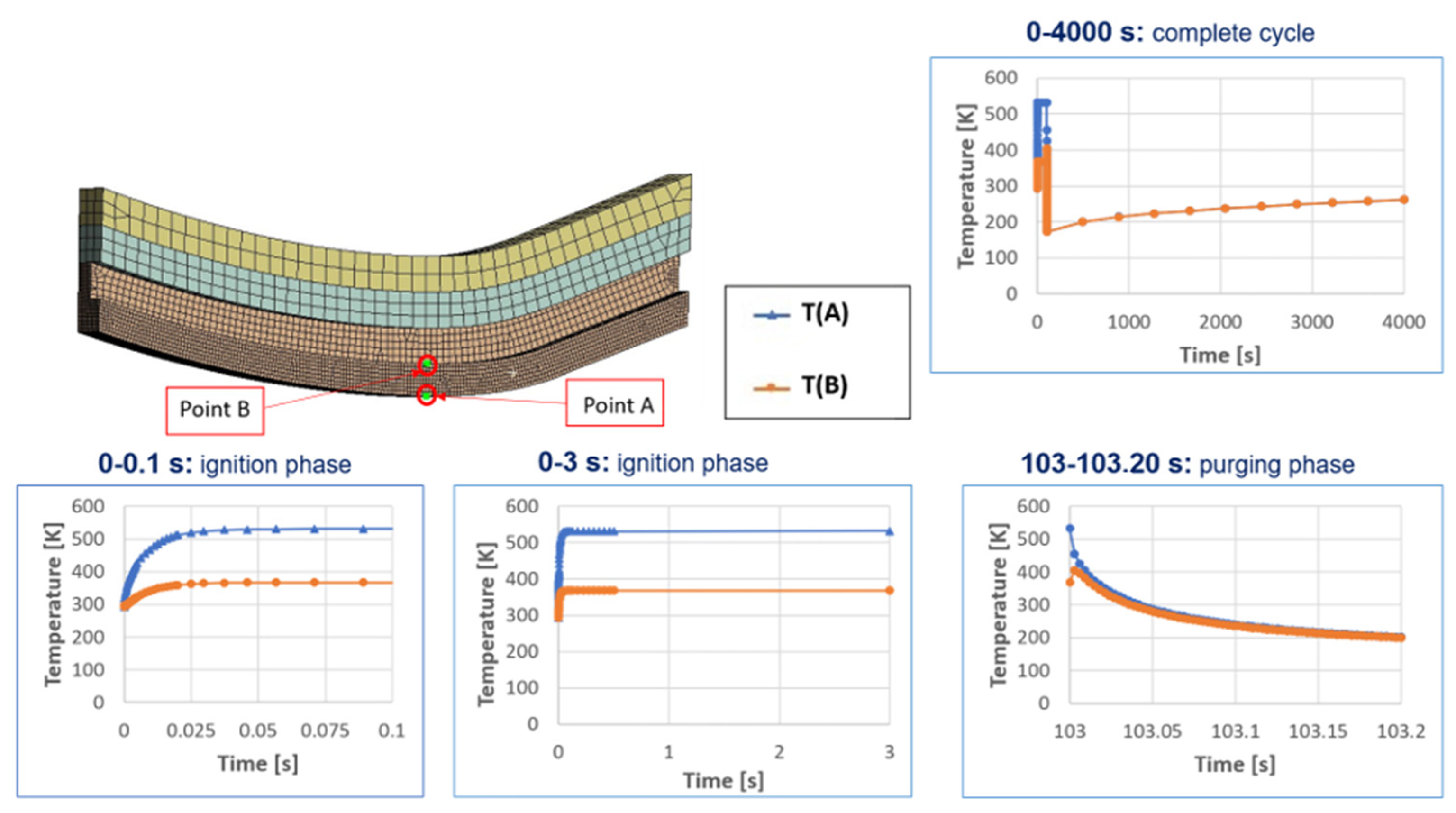
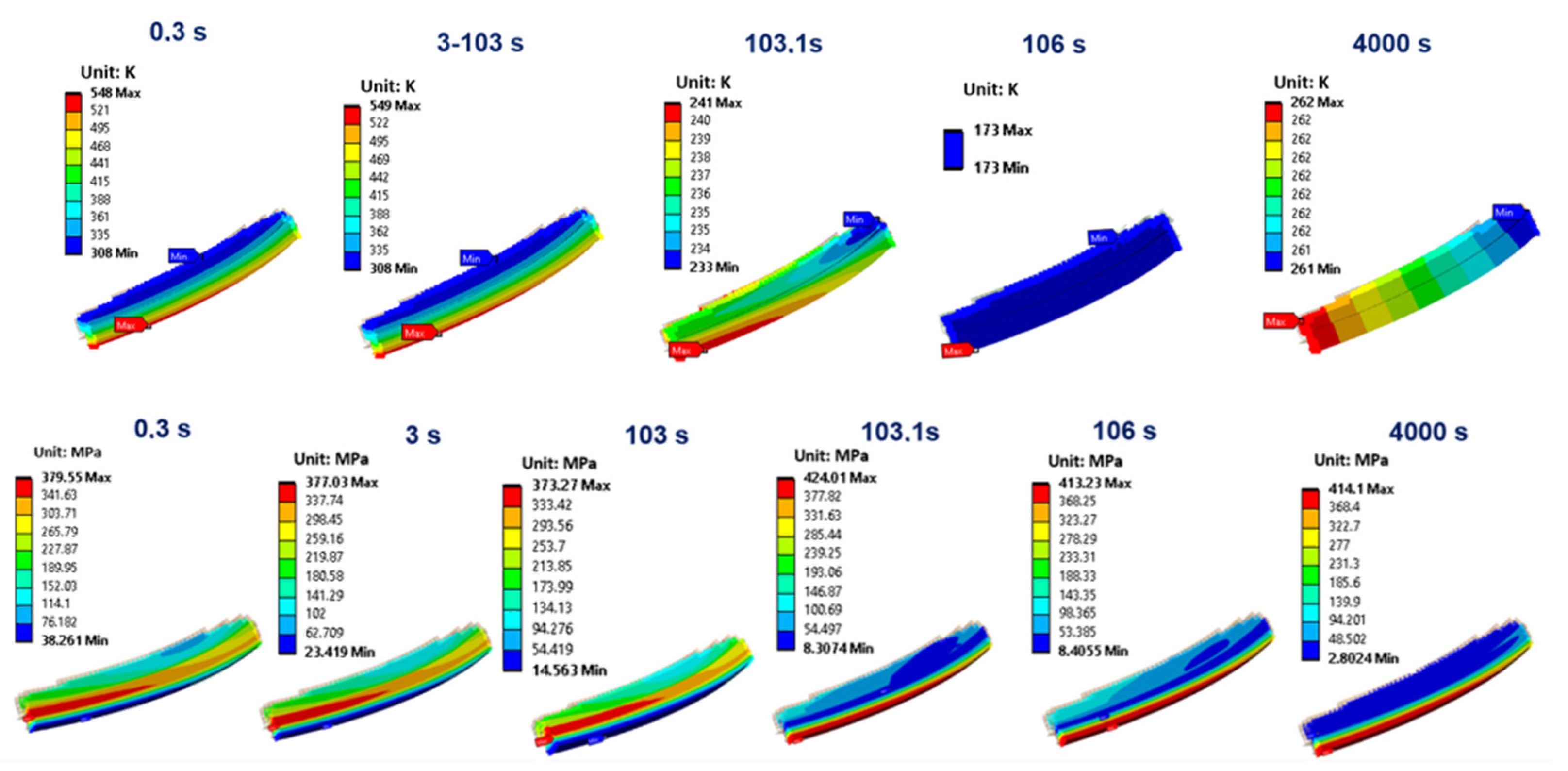

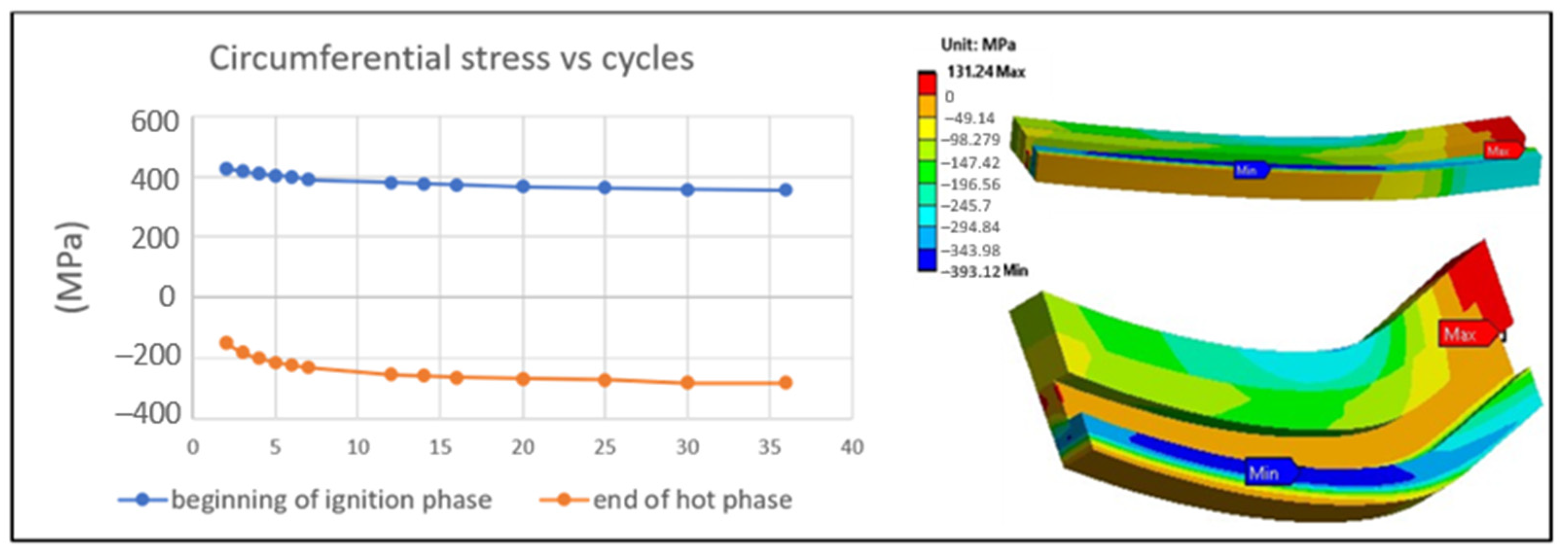
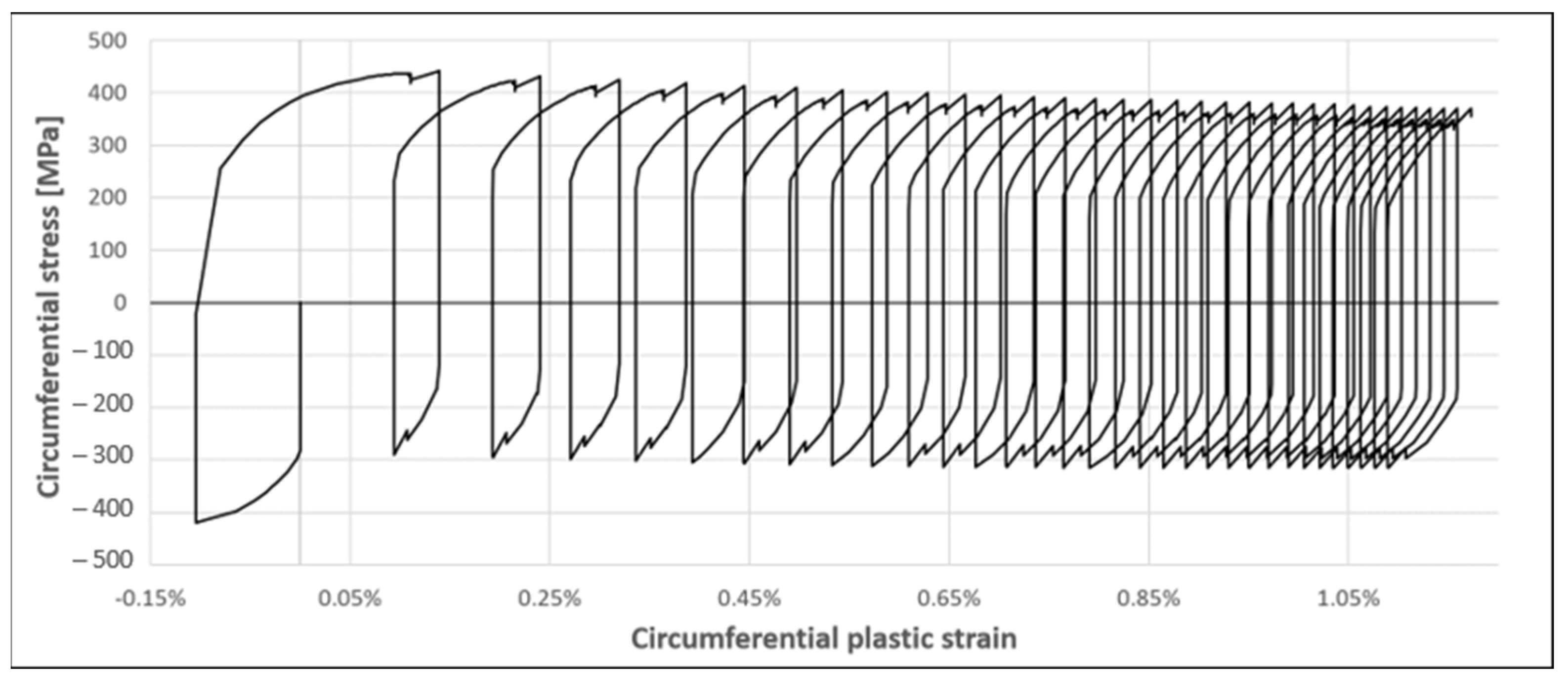
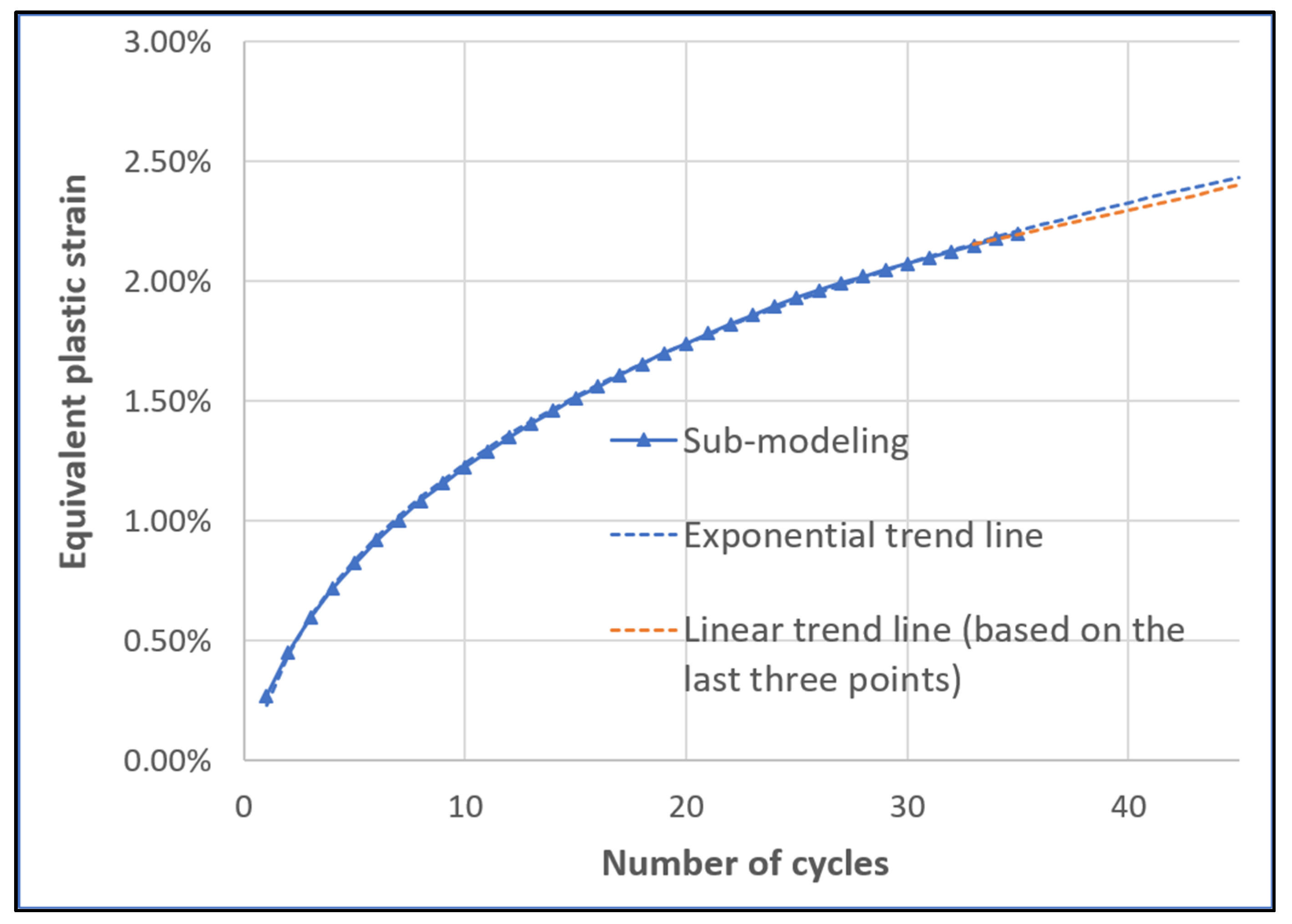

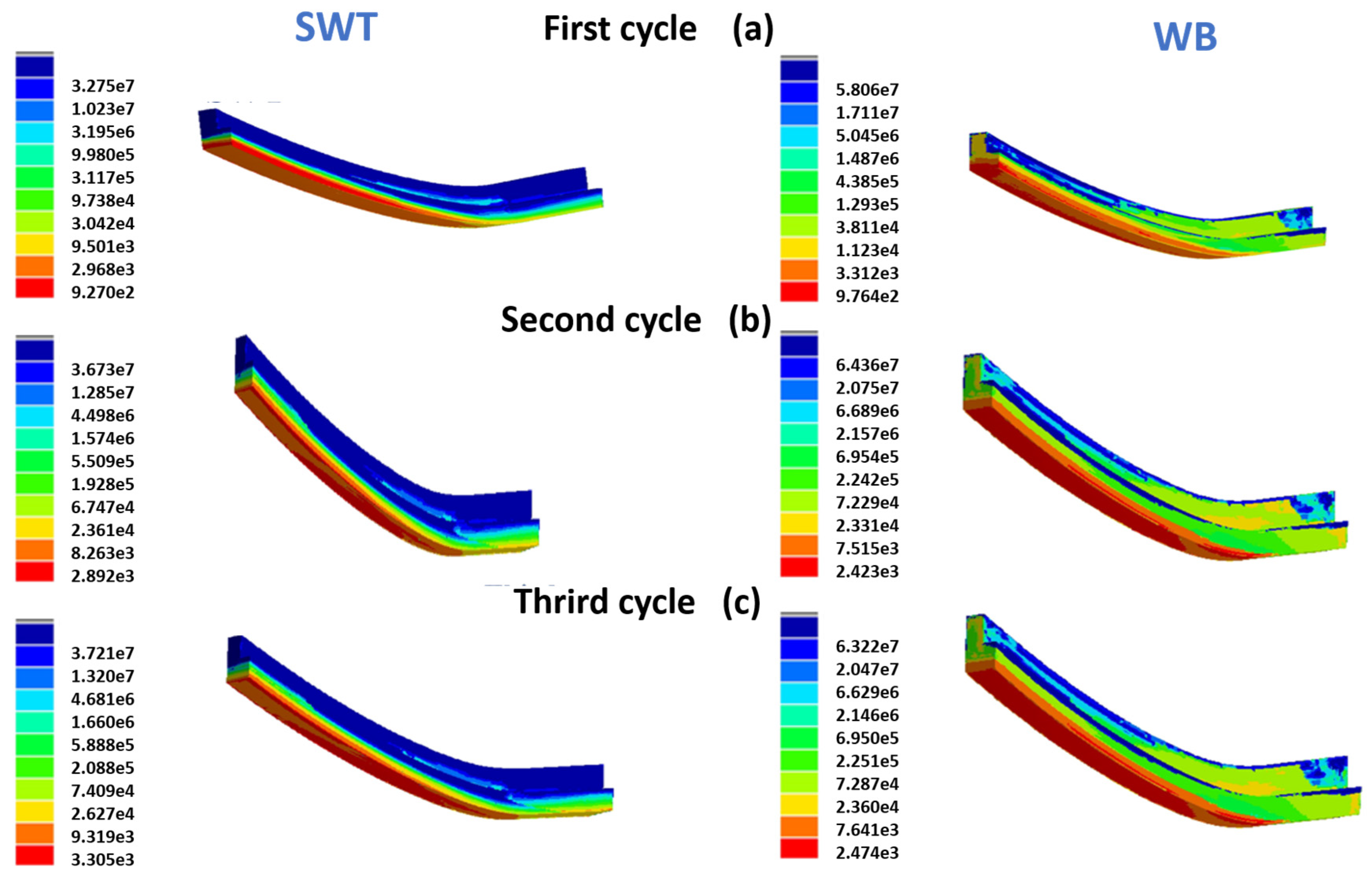
| D1 | D2 | D3 | D4 | D5 | D6 | D7 |
|---|---|---|---|---|---|---|
| 3 | −0.92 | 23,695 | 14 | 23,695 |
| Temperature [°C] | [MPa] | R0 [MPa] | [MPa] | h |
|---|---|---|---|---|
| 20 | 273 | 0 | −43 | 6 |
| 200 | 275 | 0 | −60 | 8 |
| 400 | 238 | 0 | −68 | 10 |
| 550 | 170 | 0 | −80 | 12 |
| Temperature [K] | Mass Density [kg/m3] | Thermal Conductivity [W/mK] | Specific Heat [J/kgK] | Thermal Expansion Coefficient [1/K] |
|---|---|---|---|---|
| 300 | 8933 | 320 | 390 | |
| 600 | 8933 | 290 | 390 | |
| 900 | 8933 | 255 | 400 |
| Temperature [K] | Young’s Modulus E [GPa] | Poisson’s Ratio ν | Yield Stress [MPa] | Ultimate Tensile Strength [MPa] |
|---|---|---|---|---|
| 300 | 130 | 0.3 | 433.9 | 477.9 |
| 500 | 106 | 0.3 | 383.3 | 402.9 |
| 700 | 87 | 0.3 | 313 | 329.4 |
| 900 | 44 | 0.3 | 156.3 | 174.5 |
| Temperature [K] | Mass Density [kg/m3] | Thermal Conductivity [W/mK] | Specific Heat [J/kgK] | Thermal Expansion Coefficient [1/K] |
|---|---|---|---|---|
| 300 | 8913 | 390 | 385 |
| Temperature [K] | Young’s Modulus E [GPa] | Poisson’s Ratio ν | Yield Stress [MPa] | Ultimate Tensile Strength [MPa] |
|---|---|---|---|---|
| 28 | 118 | 0.34 | 68 | 413 |
| 294 | 114 | 0.34 | 60 | 208 |
| 533 | 65 | 0.34 | 50 | 145 |
| 755 | 40 | 0.34 | 38 | 80 |
| Temperature [K] | Mass Density [kg/m3] | Thermal Conductivity [W/mK] | Specific Heat [J/kgK] | Thermal Expansion Coefficient [1/K] |
|---|---|---|---|---|
| 300 | 8913 | 90 | 444 |
| Temperature [K] | Young’s Modulus E [GPa] | Poisson’s Ratio ν | Yield Stress [MPa] | Ultimate Tensile Strength [MPa] |
|---|---|---|---|---|
| 300 | 193 | 0.3 | 344 | 551 |
| Relaxation Phase | Purging Phase | |
|---|---|---|
| Bulk temperature (K) | 300 | 173 |
| Heat transfer coefficient (W/m2K) | 50,000 | 5 |
Disclaimer/Publisher’s Note: The statements, opinions and data contained in all publications are solely those of the individual author(s) and contributor(s) and not of MDPI and/or the editor(s). MDPI and/or the editor(s) disclaim responsibility for any injury to people or property resulting from any ideas, methods, instructions or products referred to in the content. |
© 2023 by the authors. Licensee MDPI, Basel, Switzerland. This article is an open access article distributed under the terms and conditions of the Creative Commons Attribution (CC BY) license (https://creativecommons.org/licenses/by/4.0/).
Share and Cite
Ferraiuolo, M.; Giannella, V.; Armentani, E.; Citarella, R. Numerical Investigation on the Service Life of a Liquid Rocket Engine Thrust Chamber. Metals 2023, 13, 470. https://doi.org/10.3390/met13030470
Ferraiuolo M, Giannella V, Armentani E, Citarella R. Numerical Investigation on the Service Life of a Liquid Rocket Engine Thrust Chamber. Metals. 2023; 13(3):470. https://doi.org/10.3390/met13030470
Chicago/Turabian StyleFerraiuolo, Michele, Venanzio Giannella, Enrico Armentani, and Roberto Citarella. 2023. "Numerical Investigation on the Service Life of a Liquid Rocket Engine Thrust Chamber" Metals 13, no. 3: 470. https://doi.org/10.3390/met13030470
APA StyleFerraiuolo, M., Giannella, V., Armentani, E., & Citarella, R. (2023). Numerical Investigation on the Service Life of a Liquid Rocket Engine Thrust Chamber. Metals, 13(3), 470. https://doi.org/10.3390/met13030470








